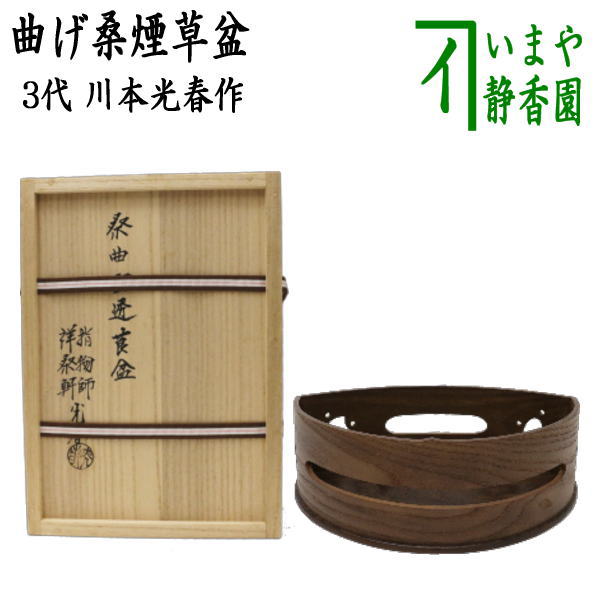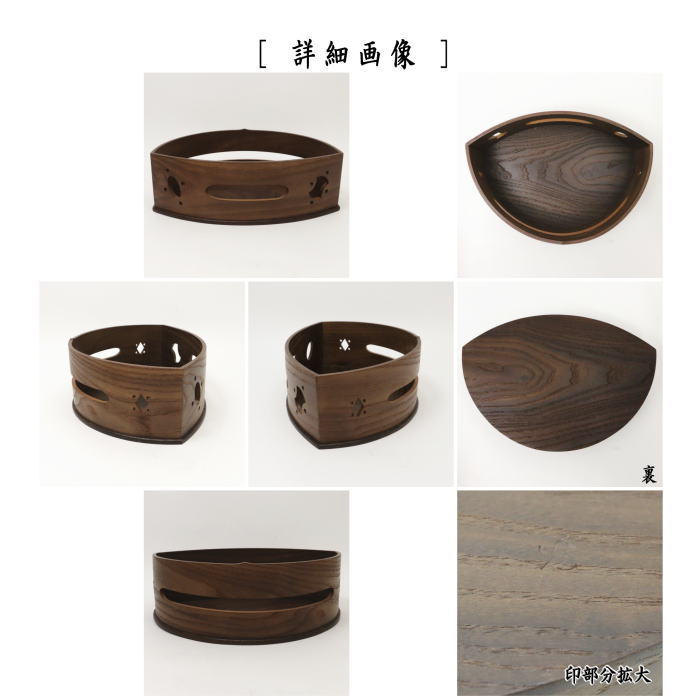1
/
of
2
[Tea utensils/Tea ceremony tools tobacco tray] Curved mulberry tobacco tray with treasure-pattern design by Mitsuharu Kawamoto III (Shosoken)
[Tea utensils/Tea ceremony tools tobacco tray] Curved mulberry tobacco tray with treasure-pattern design by Mitsuharu Kawamoto III (Shosoken)
Product Code: tabakobonn-76
Regular price
165,440 円
Regular price
Sale price
165,440 円
Unit price
/
per
Tax included.
Shipping calculated at checkout.
Couldn't load pickup availability
●What is a tobacco tray? It is a tool for storing a set of smoking equipment, such as a fire holder, ash blower, tobacco case, tobacco pipe, and incense chopsticks.
Also written as "tobacco tray," a set consisting of a tobacco tray, fire box, cupellator, tobacco box, and a pair of tobacco pipes is called a complete tobacco tray or a set of tobacco trays.
During the tea ceremony, it is served at the end of the ceremony, on the bench, or during the ceremony before the usucha tea begins.
It is not served during thick tea or kaiseki meals.
Also, at large tea ceremonies, it is placed in the seat of the main guest from the beginning.
A tobacco tray always has a fire bowl and an ash blower, and in the Sen school, the fire bowl is placed on the left and the ash blower on the right.
A tobacco case and a pipe are used as a pair, and when in use, the two pipes are hung formally in front of the tobacco tray, over the edge.
In the Mushakoji Senke school, an incense stick (kohashi) is also placed to the right of the cupellation.
In Omotesenke, paper is laid out, but in Urasenke, it is not.
At Mushakoji Senke, it is only placed under the firebox.
Originally, it was designed to resemble an incense tray, with an incense burner as a fire holder, an incense shell holder as an ash blower, and an incense box as a tobacco holder, and two tobacco pipes placed in front of the tray were said to resemble incense chopsticks.
During Rikyu's time, tobacco trays were not used at tea ceremonies, but in the Edo period, tobacco trays began to appear as a favorite item among Sotan, Enshu, and Sowa, and it is said that tobacco trays became a common item used at tea ceremonies in the late Edo period.
They come in a variety of shapes, but can be broadly divided into two types: with and without a deposit.
Chinese items include konjac sauce, abalone, lacquerware, and wisteria arrangements, while Japanese items include Chinese wood, lacquerware, woodwork, Ikkanbari, and baskets.
While the items favored by feudal lords tend to be elaborately crafted with decorative metal fittings, lacquered lacquerware, openwork carvings, and Chinese wood carvings, the items favored by tea masters are mostly simple in shape and made from wood such as paulownia or mulberry.
Size: Approx. 13cm deep x 25.8cm wide x 8.5cm high
Material: Mulberry wood, domestically produced
There is a mark of light on the bottom
Artist: Third generation Koshun Kawamoto (Shosoken)
----------
Born in 1964 as the eldest son of Mitsuharu, the second generation joiner of Shosoken
In 1984, he studied under the first Mitsuharu
In 1986, he studied under Shimada Kosei.
2001: Certified as a traditional craftsman by the Ministry of Economy, Trade and Industry
2006: Tea ceremony utensils made from old wood from the corridor of Honen-in Temple in Shishigatani, Kyoto
In 2006, he took on the name of Mitsuharu Kawamoto III.
2007: Tea ceremony utensils made from old wood from the main hall of Gyokurin-in Temple, Daitokuji, Kyoto
2009: Tea ceremony utensils made from old materials from the Jukoin storehouse at Daitokuji Temple in Kyoto
2009: Made tea ceremony utensils from old wood from the main hall of Ryoanji Temple in Kyoto (World Heritage Site)
Tea ceremony utensils made from old wood from the main hall of the Rinzai sect temple, Hokoji Temple (Shizuoka)
2013: Made tea ceremony utensils from cypress bark for the tea room (Important Cultural Property) at Jukoin, Daitokuji Temple, Kyoto
Kyoto Kenninji Temple Monk's Hall Daigodo (Zendō) Tea ceremony utensils made from old wood
2015: Tea ceremony made from old materials from Nanzenji Temple in Sakai, Osaka
Making tea ceremony utensils from the sacred cedar tree of Kamigamo Shrine, Kyoto
2016: Production of tea ceremony utensils to commemorate the 450th anniversary of the founding of Jukoin Temple, Daitokuji Temple, Kyoto
Tea ceremony utensils made from old materials from the Daitokuji Jukoin temple storehouse, old materials from the main hall of Ryoanji temple in Kyoto, and old materials from various regions
----------
Box: Wooden box
Also written as "tobacco tray," a set consisting of a tobacco tray, fire box, cupellator, tobacco box, and a pair of tobacco pipes is called a complete tobacco tray or a set of tobacco trays.
During the tea ceremony, it is served at the end of the ceremony, on the bench, or during the ceremony before the usucha tea begins.
It is not served during thick tea or kaiseki meals.
Also, at large tea ceremonies, it is placed in the seat of the main guest from the beginning.
A tobacco tray always has a fire bowl and an ash blower, and in the Sen school, the fire bowl is placed on the left and the ash blower on the right.
A tobacco case and a pipe are used as a pair, and when in use, the two pipes are hung formally in front of the tobacco tray, over the edge.
In the Mushakoji Senke school, an incense stick (kohashi) is also placed to the right of the cupellation.
In Omotesenke, paper is laid out, but in Urasenke, it is not.
At Mushakoji Senke, it is only placed under the firebox.
Originally, it was designed to resemble an incense tray, with an incense burner as a fire holder, an incense shell holder as an ash blower, and an incense box as a tobacco holder, and two tobacco pipes placed in front of the tray were said to resemble incense chopsticks.
During Rikyu's time, tobacco trays were not used at tea ceremonies, but in the Edo period, tobacco trays began to appear as a favorite item among Sotan, Enshu, and Sowa, and it is said that tobacco trays became a common item used at tea ceremonies in the late Edo period.
They come in a variety of shapes, but can be broadly divided into two types: with and without a deposit.
Chinese items include konjac sauce, abalone, lacquerware, and wisteria arrangements, while Japanese items include Chinese wood, lacquerware, woodwork, Ikkanbari, and baskets.
While the items favored by feudal lords tend to be elaborately crafted with decorative metal fittings, lacquered lacquerware, openwork carvings, and Chinese wood carvings, the items favored by tea masters are mostly simple in shape and made from wood such as paulownia or mulberry.
Size: Approx. 13cm deep x 25.8cm wide x 8.5cm high
Material: Mulberry wood, domestically produced
There is a mark of light on the bottom
Artist: Third generation Koshun Kawamoto (Shosoken)
----------
Born in 1964 as the eldest son of Mitsuharu, the second generation joiner of Shosoken
In 1984, he studied under the first Mitsuharu
In 1986, he studied under Shimada Kosei.
2001: Certified as a traditional craftsman by the Ministry of Economy, Trade and Industry
2006: Tea ceremony utensils made from old wood from the corridor of Honen-in Temple in Shishigatani, Kyoto
In 2006, he took on the name of Mitsuharu Kawamoto III.
2007: Tea ceremony utensils made from old wood from the main hall of Gyokurin-in Temple, Daitokuji, Kyoto
2009: Tea ceremony utensils made from old materials from the Jukoin storehouse at Daitokuji Temple in Kyoto
2009: Made tea ceremony utensils from old wood from the main hall of Ryoanji Temple in Kyoto (World Heritage Site)
Tea ceremony utensils made from old wood from the main hall of the Rinzai sect temple, Hokoji Temple (Shizuoka)
2013: Made tea ceremony utensils from cypress bark for the tea room (Important Cultural Property) at Jukoin, Daitokuji Temple, Kyoto
Kyoto Kenninji Temple Monk's Hall Daigodo (Zendō) Tea ceremony utensils made from old wood
2015: Tea ceremony made from old materials from Nanzenji Temple in Sakai, Osaka
Making tea ceremony utensils from the sacred cedar tree of Kamigamo Shrine, Kyoto
2016: Production of tea ceremony utensils to commemorate the 450th anniversary of the founding of Jukoin Temple, Daitokuji Temple, Kyoto
Tea ceremony utensils made from old materials from the Daitokuji Jukoin temple storehouse, old materials from the main hall of Ryoanji temple in Kyoto, and old materials from various regions
----------
Box: Wooden box
[About paid individual packaging]
If you would like individual packaging (charges apply), click View Cart, check "I would like individual packaging", and then add the desired quantity to "Quantity".
*The following products are not eligible for individual packaging. If you would like to package the folding fan or colored paper, we will provide a paid box or bag for each.
- Mail delivery products
- Folding fan (paid box available/no packaging)
- Colored paper (paid bag available/no packaging)
- Zodiac theme related products
【Related Category】
Share
![[Tea utensils/Tea ceremony tools tobacco tray] Curved mulberry tobacco tray with treasure-pattern design by Mitsuharu Kawamoto III (Shosoken)](http://imaya.co.jp/cdn/shop/products/tabakobonn-76_1.jpg?v=1709095410&width=1445)
![[Tea utensils/Tea ceremony tools tobacco tray] Curved mulberry tobacco tray with treasure-pattern design by Mitsuharu Kawamoto III (Shosoken)](http://imaya.co.jp/cdn/shop/products/tabakobonn-76_2.jpg?v=1709095410&width=1445)






















